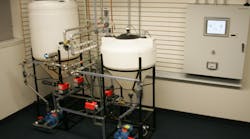Process and Data Automation uses internally constructed skids as training and development tools for its staff, during both initial construction and ongoing laboratory sessions.
For a relatively small company, Process and Data Automation, a systems integrator in Erie, Penn., does an impressive amount of training. Joseph W. Snyder, president, says, “We have 29 total people, with 20 in the controls engineering department. In addition to vendor-supplied training and continuing education through organizations such as ISA and the Project Management Institute (PMI), our company has created miniature processing systems here at our site.”
Process and Data Automation has a multitude of simple processing labs used by its team to learn new field equipment, controllers and control methods such as:
- Simple sensor integration to controller;
- Instrumentation setup;
- VFD configuration;
- Networked I/O commissioning;
- Simple control loop programming; and
- Complex system programming.
“We use home-constructed systems to accomplish this,” explains Snyder. “Many of the systems have multiple PLC platforms per skid, so we can cross-train staff on more than one control platform and learn how signals are processed differently by various equipment suppliers.”
For example, a scale-model clean-in-place (CIP) skid features motorized valves, multiple types of flow and level instrumentation, variable speed pump control, a heat exchanger and a Rockwell Automation Logix Batch & Sequence Manager controller.
Many of the systems were built in cooperation between the internal staff and Penn State University students as part of their senior year design projects.
Read More: Innovative Methods of Instruction Take Training Out of the Classroom
Process and Data Automation has built several of these trainers, all of which emulate real-world systems. “The idea is not to mimic everything we encounter in the field, but rather to expand training to include real field devices and applications,” notes Snyder.
The company also uses vendor training for deep dives on technical facets of a system, such as a programming language, network configuration or a specific instrument type, and supplements that training on the skids. “Our systems allow us to take what’s learned in theory-heavy classes and put that into actual operation. Our engineers don’t need to make the leap from a theory course to directly working on live equipment at a client’s site. This allows them to make the proper mental connections and really understand how the theoretical world interacts with physical connections.”




